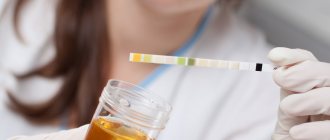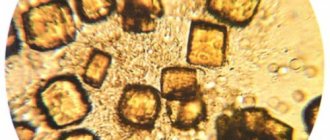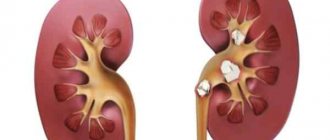What epithelium can normally be found in a child’s urine?
Our body is a constantly renewing system; cells age, die, and are replaced with new ones. These processes invariably occur in the urinary system, so sometimes a certain amount of desquamated old epithelium can be found in the urinary sediment.
Types of epithelium in urinary sediment
When examining urine, the following epithelium may be detected:
- Flat. It lines the urinary tract, urethra, and vagina. Therefore, in females, detection of it in urine is common. In girls, the detection of squamous epithelium in the urine indicates puberty.
- Renal. During normal functioning of the body, the renal epithelium is not detected in the urine of a child or an adult. Single cells are allowed in newborns. If, when examining urine using available methods, it is possible to detect renal epithelium, then a more thorough examination of the patient is needed. Because This situation may indicate severe kidney damage.
- Transition. It is a typical epithelium for the bladder and ureters, and also covers part of the urethra. It is considered acceptable when the transitional epithelium in the urine can be easily counted - i.e. single cells are found.
Pathological conditions in which the epithelium in the urine increases
For each type of epithelium there are characteristic pathological conditions of the kidneys (Table 1).
Table 1. Causes of epithelium in urine.
| Type of epithelium | Kidney pathology |
| Flat | Urinary tract infection |
| Renal | Acute inflammatory processes in the kidneys, toxic and autoimmune kidney damage (renal failure, glomerulonephritis, nephrotic syndrome, inflammation of the pyelocaliceal system (pyelonephritis), amyloidosis, nephrosis and others). |
| Transition | Cystitis, urolithiasis, taking medications, malignant kidney tumors. |
Squamous epithelium in a child’s urine can normally be found in small quantities, but as such, an increase in its content in urine does not have diagnostic value.
Reasons for deviations
The most common causes of an increased content of epithelial cells in a child’s urine are pathologies of the urinary system. If the level of epithelial cells in a child’s urine is increased, this may be a sign of inflammatory diseases of the urethra, bladder and kidneys: cystitis, urethritis, pyelonephritis. The appearance of epithelium in urine may also be associated with diseases of other organs, in particular the genitals (vulvitis in girls, orchitis and vesiculitis in boys).
The level of epithelial cells in a child’s urine may increase due to non-compliance with urine collection rules.
Insufficient or improper intimate hygiene can increase epithelium in the urine of a child.
Taking certain medications can increase the level of epithelium in a child's urine.
Epithelium in a child’s urine may exceed the norm due to complications of bacterial and viral infections, prolonged course of purulent inflammatory processes, for example, sore throat.
If the level of epithelial cells in a child's urine is elevated, this may be a sign of inflammatory diseases of the urethra, bladder and kidneys.
There are also other causes of this disorder. These include:
- non-compliance with urine collection rules,
- insufficient or incorrect intimate hygiene,
- taking certain medications,
- complications of bacterial and viral infections, long-term course of purulent inflammatory processes (angina, furunculosis).
If a child, shortly before taking a urine test, suffered poisoning or trauma to the urethra (for example, during catheterization or surgery), this can also cause the appearance of epithelial cells in the urine.
A large amount of epithelium is observed in the urine of children with a neurogenic bladder and those who suffer from vesicoureteral reflux. With this disease, urine is refluxed from the bladder into the kidneys and ureters and epithelial cells are desquamated from the mucous membrane of the urinary tract.
Cystitis
With cystitis, characterized by inflammation of the mucous membrane of the bladder, transitional epithelium is found in the urine. In girls, many squamous epithelial particles are observed along with an increase in white blood cell levels.
Urethritis
With inflammation of the urethra, an increased number of transitional epithelial cells also appears in the urine. To distinguish urethritis from cystitis, after a general urinalysis, an additional three-glass urine sample is performed, which involves collecting three different portions of urine during one urination. If, in addition to epithelial cells, the results of this study reveal leukocytes, and they are present in the greatest numbers in the first portion of urine, inflammation of the urinary canal is diagnosed.
Kidney pathologies
In kidney pathologies, renal epithelial cells are present in the urine. This may be a sign of diseases such as pyelonephritis, glomerulonephritis, hydronephrosis, tubular necrosis, pyelitis. A similar symptom occurs with kidney stones and congenital anomalies of the development of this organ.
Test to determine squamous epithelium in urine
How to properly collect urine for analysis?
Determination of epithelium in urine is included in OAM. Therefore, how the patient prepares for the analysis will affect the results of the study.
Before submitting your urine for analysis, you should refrain from eating foods that color your urine, such as beets.
It is also important to consult with your doctor about what medications you are taking to determine whether this may affect your test results.
Medicines are excreted in the urine, so they can distort the results of the study.
Also, before donating urine, you need to prepare a sterile, dry container. You can buy a container for this at a pharmacy or use a baby food jar, having previously sterilized it.
An important manipulation when collecting urine is to carry out hygienic procedures using warm water and soap. This is necessary, since epithelium from the skin, if it gets into a container with urine, can distort the results - this will be regarded as a pathology.
In girls, slight detection of squamous epithelial cells in the urine is allowed. But this does not mean that you should neglect washing before collecting urine.
The sequence of actions when collecting urine is as follows:
- Prepare the container in the evening.
- In the morning after waking up, do not go to the toilet.
- Toilet the external genitalia.
- Flush the first third of your morning urine down the toilet.
- The rest of the urine is collected in a container.
- The container must be taken to the laboratory within 2 hours.
It is not recommended to donate urine during menstruation.
Also, in young children with uncontrolled urination, urine bags are used to collect urine, which can be purchased at the pharmacy. The urine bag is glued to the pubis. When the baby does “his business,” the urine is poured into a sterile, dry container.
What methods are used to determine squamous epithelium in urine in children?
The epithelium in a child’s urine is determined by microscopic examination of the sediment. Urine from the patient is centrifuged. The top layer is drained, and the sediment is examined under a microscope.
In addition to various types of epithelium, microscopic examination of urine can reveal salts, red blood cells, white blood cells, casts, and crystals.
Squamous epithelium in urine analysis in a child: why it is increased, treatment
Microscopic examination of urinary sediment for epithelial cells is one of the components of a general urine test.
The epithelium in this biological fluid can be detected both normally and in the presence of problems with the patient’s genitourinary system. The diagnosis is determined based on the quantitative determination of cells, as well as their type.
Types of cells
Epithelial cells found in urine can get there from various areas of the genitourinary system. To make an accurate diagnosis, when carrying out work, the laboratory technician must not only determine the type of sediment detected, but also the location of the epithelial cells.
These types of cells are found in urine.
- In the female body they line the distal part of the urethra, labia, and vagina.
- In boys, squamous epithelial cells in the urine can only be detected through their migration from the cavernous zone of the urethral canal.
Cover the cavity of the renal pelvis, ureter and ureter. In girls they can be found in the proximal zone of the urethral canal, and in boys - in the prostatic zone.
This type of tissue is characterized by the presence of relatively large cells on the surface that have a pear-shaped or flattened appearance. They contain two nuclei, as well as additional fusiform vesicles. This tissue is characterized by invagination of the membrane into the inner part of the cytoplasm.
They differ in appearance depending on the location in the kidney tubules.
In the proximal zone there is a single-layer type of cuboidal epithelium. Its cells contain one large nucleus, which is located in the central part of the cytoplasm. In addition, they have a brush border in the lumen. In the distal zone, the epithelium is formed by a light type of cubic cells in which there is no brush border.
If squamous epithelium is detected in the urine of a child, the doctor needs to understand the location of the disease that provoked such a symptom.
Clinical urine analysis takes into account not only the properties of the biological material, but also the microscopic data of the sediment that is contained in it. After the study is completed, a general table of results is created, which allows you to compare the norm with the data obtained in the laboratory for a particular patient.
The number of epithelial cells in a child’s urine directly depends on his age. Normally, their number should be single – no more than 3–10 units.
Microscopic analysis of a child's urine sediment can reveal up to 5 units of squamous epithelium from the ureteral mucosa, as well as up to 3 units. transitional - from other parts of the patient’s genitourinary system.
If a child is over 14 years old, a urine test should not reveal renal cells of the epithelial tissue.
In newborns
In infants, when examining urine, laboratory assistants can detect epithelial cells of three possible types - this is due to the fact that during this period the genitourinary system is adapting to an existence that is not associated with the use of the mother’s body.
In teenagers
During adolescence, the body undergoes a number of hormonal changes. Because of this, in a urine test, the norm in children after 14 years of age suggests the presence of up to 10 epithelial cells of all existing types, except kidney.
For girls
The anatomy of the genitourinary system of the female body ensures that urine comes into contact with the labia during the process of excretion. In addition, hygiene procedures often contribute to significant detachment of epithelial tissue. In this regard, in some cases, it is possible to detect a larger amount of epithelium than the norm in a clinical study of girls’ urine.
Collection of urine test
A general urine test must be taken during all examinations of the child. It is also indicated for planned hospitalization or suspected diseases of the genitourinary system. In order to obtain objective results of the study, it is necessary to follow the following rules for collecting urine:
- Biological material must be placed in a clean and dry container that does not contain organic residues or detergents. It can be made of plastic or glass. Doctors recommend purchasing sterile containers from pharmacy kiosks to collect urine.
- Before urinating, you must complete all hygiene procedures.
- For the study, you need to use the first portion of urine collected in the morning.
- No more than 90 minutes should pass between the collection of biomaterial and its delivery to the laboratory for analysis.
If there is a suspicion of acute inflammation, the child’s doctor may additionally prescribe a urine test according to Nechiporenko.
The analysis allows you to determine the number of white and red blood cells, as well as cylinders in the patient’s biological material. Detection of the latter is evidence of the presence of renal pathology.
In order to clarify the location, doctors prescribe a sample of 3 glasses. It involves collecting one portion of urine in three containers. Thus, the first part of the biological material, its main volume and the last part are submitted for analysis.
Anomalies
- Renal-type epithelial cells in the urine of a child over 14 years old indicate the appearance of nephrosis or nephritis in the acute stage.
- Transitional cells are found when there is inflammation in the ureter, bladder and urethra. The discovery of an increased number of leukocytes confirms this doctor’s assumption.
- If one epithelial cell is detected during the analysis, the laboratory assistant must conduct a second microscopy of this volume of material or take a second portion of urine.
Reasons for deviations
The most common causes of epithelial cells in urine are:
- incorrect urine collection;
- inflammation in the organs of the urinary system;
- some other diseases;
- appearance and migration of stones;
- taking certain medications;
- failure to comply with hygiene procedures;
- reverse flow of urine;
- intoxication.
An excessive number of transitional cells in a child’s urine occurs in the following cases:
- for inflammation caused by cystitis and urethritis;
- with urolithiasis;
- during catheterization.
Epithelial kidney cells end up in the urine due to kidney pathologies. They can be bacterial or autoimmune in nature.
Cystitis
Inflammation of the bladder mucosa, cystitis is characterized by detachment of transitional epithelial cells in the affected area. Doctors consider infection caused by bacteria or hypothermia to be the main causes of this disease.
In most cases, cystitis is caused by E. coli. The main symptom of this disease is pain when urinating.
Due to the anatomical features of the body, girls develop cystitis much more often than boys.
- Take note: Monurel for children against cystitis
Urethritis
When the urethra becomes inflamed, doctors diagnose patients with urethritis. It can have both infectious and non-infectious etiology. Experts consider the following pathogens to be the most common causative agents of the disease:
- ureaplasma;
- mycoplasma;
- Trichomonas.
Sometimes urethritis occurs due to damage to the mucous membrane by stones passing through the urethra. The disease in this case appears due to autoimmune processes.
The main symptom of urethritis is painful urination accompanied by burning and itching. Some patients experience mucous discharge.
Kidney pathology
Kidney pathologies glomerulonephritis and pyelonephritis are considered one of the most common. Characterized by the occurrence of inflammatory processes in various parts of the organ. Because of this, epithelial cells peel off in areas where the disease develops.
Urolithiasis is a dangerous kidney disease. Stones, while moving through the ureter, can mechanically damage its mucosa, thereby causing exfoliation of the epithelium. Such injuries ultimately become a gateway to infections and inflammation.
Treatment
Self-treatment is not recommended; there is a risk of adverse consequences.
If an increased amount of epithelium is detected in a child’s urine test, if he does not have symptoms of the disease, the doctor should order additional tests
- additional tests of urine and blood,
- performing ultrasound,
- and other diagnostic techniques.
Depending on the data obtained through a systemic examination, a decision is made to prescribe antibiotics, NSAIDs or other groups of medications.
▼We RECOMMEND YOU TO STUDY▼
What is analyzed when obtaining analysis results?
Normal indicators
Flat epithelium in males with proper toileting is not detected at all. In females, up to 5 cells are allowed, taking into account the epithelium from the vagina.
For a newborn, the norms are slightly different, as his body gets used to life outside the womb.
Increased squamous epithelium in the urine in children and conditions that provoke it
In cases where certain types of epithelium are suddenly found in large quantities in the urinary sediment, the first thing to decide is whether the urine was collected correctly? Most often, the cause of the situation is inadequate hygiene measures taken before donating urine.
Also, 14 days after the baby is born and adapts to new living conditions, the amount of exfoliating epithelium should decrease. If this does not happen and a high number of cells is still found in the urine, despite careful toileting of the external genitalia, then we are talking about pathology.
For example, an increased content of squamous epithelium found in urinary sediment during a general urine test allows one to suspect an inflammatory process in any part of the urinary tract.
Necessary actions when detecting a deviation from the norm
If the results reveal transitional epithelium in the child’s urine, changes in sediment, changes in well-being and symptoms characteristic of pathology appear, you must visit a doctor for advice.
More on the topic: Why does the urethra itch?
The following symptoms are recognized as the most acute and dangerous:
- discomfort and pain when urinating;
- pain and discomfort in the lumbar region;
- urinary incontinence;
- loss of appetite, disruption of rest and sleep patterns, weakness and lethargy;
- regurgitation in newborns, without any reason;
- increased body temperature of the child, especially if it is poorly relieved by antipyretics;
- surges in blood pressure and swelling of the legs and face.
If several symptoms appear, it is necessary to conduct an examination with a doctor and give urine to analyze the number of leukocytes and red blood cells, bacteria and salts, protein deposits and mucus in the liquid. It is also necessary to donate blood for a general analysis, which will reveal inflammatory processes and non-inflammatory pathologies, anemia.
Recommendations for parents
The reliability of the study depends on how aware parents are of the manipulations during the delivery of biological material. Therefore, do not hesitate to ask your doctor about how to properly prepare for the test.
Also, deciphering the analysis results should be entrusted to a specialist, and not done on your own.
Sometimes self-medication based on research results can cause more harm.
Types of urinary tract epithelium
There are several types of common epithelial cells lining human insides. The presence of a certain type of epithelium in the analysis tells the specialist which organ may have pathological changes, and allows you to decide on further diagnostic procedures. This is necessary for adequate and effective treatment of the child.
All organs, mucous membranes, blood vessels and skin are a collection of epithelial cells, the types of which are distributed differently depending on their location:
- flat (stratified) epithelium covers the urinary canal in boys, the vagina and external genitalia (lips) in girls;
- cells of a transitional type (cubic, cylindrical) line the bladder, prostate duct, ureters, pelvis of bean-shaped kidneys;
- Kidney cells line the lining of the tubular system inside the kidney.
Reasons for the increase in numbers
An increase in the number of squamous and transitional epithelial cells, especially in combination with the appearance of renal epithelial cells, indicates the development of pathological processes in the urinary or genital area. If, during the deciphering of the urine test, it turned out that the squamous epithelium is elevated, then, taking into account the specifics of its localization, the doctor will immediately suspect the following diseases:
- Urethritis is inflammation of the urethra (urethra).
- Inflammatory processes associated with hypothermia - in boys, orchitis (inflammation of the testicle), epididymitis (inflammation of the epididymis), vesiculitis (inflammation of the spermatic cord), in girls - vulvitis (inflammation of the vagina).
Urethritis - an inflammatory process in the urethra - one of the reasons for the appearance of squamous epithelium in the urine
And also an increase in these cells can be observed due to improper preparation for the test, namely insufficient quality toileting of the genital organs before urine collection, violation of the basic rules when collecting and transporting biomaterial (urine).
It should be noted that the first two points are most often accompanied by a significant excess of squamous epithelial cells compared to normal values. Whereas in the last two situations, the jump in values is usually not high, and most likely, a repeat urine test will be required with more careful implementation of all necessary recommendations.
Increased content of flat and transitional epithelial cells
If in young patients, along with an increase in the number of squamous epithelium, transitional type cells appear, this tells the doctor about the spread of the inflammatory process up the urinary tract. The most common causes of surges in these epithelial cells are:
- Diseases of the lower genitourinary tract of an inflammatory and infectious nature (cystitis (inflammation of the bladder), urethritis).
- Inflammation of the mucous membrane of the ureters, renal pelvis (pyelonephritis, pyelitis), including those developing against the background of urolithiasis as a complication.
- Dysmetabolic nephropathy is the spontaneous discharge of salt accumulations or renal sand, accompanied by damage to the mucous surface of the urinary tract.
There is a high probability that when urine is collected from a child using a catheter, an increased content of transitional epithelium will be detected in the sample. If at least single kidney-type cells are detected in urine, this is regarded as a deviation from the norm and requires further diagnostics to find the cause of the disorder.











